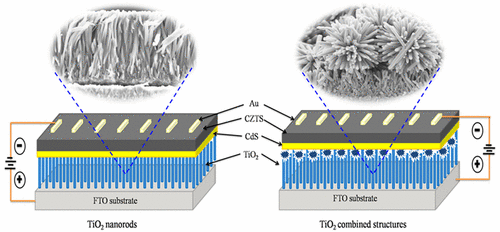当前位置:
X-MOL 学术
›
Cryst. Growth Des.
›
论文详情
Our official English website, www.x-mol.net, welcomes your feedback! (Note: you will need to create a separate account there.)
Morphology Controlled n-Type TiO2 and Stoichiometry Adjusted p-Type Cu2ZnSnS4 Thin Films for Photovoltaic Applications
Crystal Growth & Design ( IF 3.8 ) Pub Date : 2017-08-28 00:00:00 , DOI: 10.1021/acs.cgd.7b00632 S. Varadharajaperumal 1 , Chinnaiyah Sripan , R. Ganesan , Gopalkrishna Hegde , M. N. Satyanarayana 1
Crystal Growth & Design ( IF 3.8 ) Pub Date : 2017-08-28 00:00:00 , DOI: 10.1021/acs.cgd.7b00632 S. Varadharajaperumal 1 , Chinnaiyah Sripan , R. Ganesan , Gopalkrishna Hegde , M. N. Satyanarayana 1
Affiliation

|
This paper presents the fabrication and characterization of stoichiometry adjusted Cu2Zn1.5Sn1.2S4.4 thin film (FTO/TiO2/CdS/CZTS/Au) photovoltaic (PV) devices. The PV devices were developed using the window layer of rutile TiO2 nanoarchitecture arrays, i.e., one-dimensional (1D) nanorods and three-dimensional (3D) combined/hierarchical structures (nanorods with microspheres). One-dimensional (1D) nanorods and 3D combined structures of TiO2 window layers were synthesized by a hydrothermal method with different solvents without any assistance of surfactants and templates. We achieved two kinds of TiO2 nanostructures by tuning the precursor concentrations and volume by keeping a constant growth time and temperature. The detailed structural properties were studied using X-ray diffraction and high resolution transmission electron microscopy. Phase formation and chemical state of the prepared samples were examined by Raman spectroscopy and X-ray photoelectron spectroscopy. The surface morphology and luminescence studies of TiO2 nanostructures were analyzed using field emission scanning electron microscopy and cathodoluminescence techniques. The current–voltage performance of fabricated devices were measured under an AM 1.5 solar simulator. It is observed that combined structure PV device shows better efficiency (1.45%) than the nanorods alone structure (0.55%). Present work is a first attempt made to construct the inverted CZTS based solar cells. This study establishes the window layer of hierarchical TiO2 nanostructures based morphology that offers a great potential for the development of high-efficiency nonstoichiometric CZTS based solar cells.
中文翻译:

用于光伏应用的形态学控制的n型TiO 2和化学计量比调整的p型Cu 2 ZnSnS 4薄膜
本文介绍了化学计量调整的Cu 2 Zn 1.5 Sn 1.2 S 4.4薄膜(FTO / TiO 2 / CdS / CZTS / Au)光伏(PV)器件的制备和表征。使用金红石型TiO 2纳米结构阵列的窗口层(即一维(1D)纳米棒和三维(3D)组合/分层结构(带有微球的纳米节))开发了PV器件。TiO 2窗口层的一维(1D)纳米棒和3D组合结构是通过水热法在不同表面活性剂和模板的帮助下,用不同的溶剂合成的。我们实现了两种TiO 2通过保持恒定的生长时间和温度来调节前驱物的浓度和体积,从而形成纳米结构。使用X射线衍射和高分辨率透射电子显微镜研究了详细的结构性能。通过拉曼光谱和X射线光电子能谱检查制备的样品的相形成和化学状态。TiO 2的表面形貌和发光研究纳米结构使用场发射扫描电子显微镜和阴极发光技术进行了分析。人造设备的电流-电压性能是在AM 1.5太阳模拟器下测量的。观察到组合结构的PV器件显示出比单独的纳米棒结构(0.55%)更好的效率(1.45%)。当前的工作是构造反向CZTS太阳能电池的首次尝试。这项研究建立了基于TiO 2纳米结构的分层形态的窗口层,这为开发高效非化学计量CZTS基太阳能电池提供了巨大的潜力。
更新日期:2017-08-29
中文翻译:

用于光伏应用的形态学控制的n型TiO 2和化学计量比调整的p型Cu 2 ZnSnS 4薄膜
本文介绍了化学计量调整的Cu 2 Zn 1.5 Sn 1.2 S 4.4薄膜(FTO / TiO 2 / CdS / CZTS / Au)光伏(PV)器件的制备和表征。使用金红石型TiO 2纳米结构阵列的窗口层(即一维(1D)纳米棒和三维(3D)组合/分层结构(带有微球的纳米节))开发了PV器件。TiO 2窗口层的一维(1D)纳米棒和3D组合结构是通过水热法在不同表面活性剂和模板的帮助下,用不同的溶剂合成的。我们实现了两种TiO 2通过保持恒定的生长时间和温度来调节前驱物的浓度和体积,从而形成纳米结构。使用X射线衍射和高分辨率透射电子显微镜研究了详细的结构性能。通过拉曼光谱和X射线光电子能谱检查制备的样品的相形成和化学状态。TiO 2的表面形貌和发光研究纳米结构使用场发射扫描电子显微镜和阴极发光技术进行了分析。人造设备的电流-电压性能是在AM 1.5太阳模拟器下测量的。观察到组合结构的PV器件显示出比单独的纳米棒结构(0.55%)更好的效率(1.45%)。当前的工作是构造反向CZTS太阳能电池的首次尝试。这项研究建立了基于TiO 2纳米结构的分层形态的窗口层,这为开发高效非化学计量CZTS基太阳能电池提供了巨大的潜力。



























 京公网安备 11010802027423号
京公网安备 11010802027423号